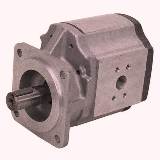
Mounting
You can put the mount any way you want. It comes in two bolt and four bolt that have a pilot for the area it is in. The part of the unit that has the pilot needs to have a .039 in. chamber to make sure it gets installed correctly. If you use flexible hose it will cut down on the vibration if your pipes are rigid on the ports.
Rotation
You can find the shaft rotation in the codes. You can find it on the unit, in bold letters..INJECT and ROTATION arrows around the drive shaft on the body of the pump. To know the way it should be pointing, you can find that by the drive shaft.
Pump Suction Line
Your line needs to be pretty large and not around sharp bands so the pump inlet don’t get to low. The way it is setup it shouldn’t get air in it and always have enough oil at all times. On the inlet it shouldn’t get below 7.5 inches and .25 bar atmospheric pressure. If your pressures are low, the cold start up should only be in diminished intervals. In a pump suction line the fluid speed shouldn’t go over 2m/sec. and if your pipe is as long as six feet or so. If the pipe is longer, get with a mechanic about it.
Oil Reservoir
Most of the time you should have in your reservoir at least twice the amount of an open loop flow that is being taken out of the reservoir. If you mobile it should be .75 times the amount. To give enough air space and breathing room you will need to account for the volume for your rams and actuators. Your line in the pump suction needs to be four inches for drawing oil, so you want be picking up what is on the bottom of the tank such as dirty deposits. You will need to put the suction and return lines needs to be well apart from one another, so that you have good circulation inside the tank to help with cooling and help the air to travel in the oil to deplete.
Filtration
You will need to filter out your fluids before you start up and run your unit. And it will give it a cleaner level and give the unit a longer life. Depending on the way the unit is designed it will give the system a better mode of operation.
Shaft Seals
On most shaft seals, the PSI of 70 is most common for back pressure in motor return lines and case pressure in pumps. You can take it up to 145 PSI for lesser intervals on a cold start up. There are double shaft seals, but that is mainly used if it put on an engine or gear box, but that is used when the fluid is outside the pump mounting flange. You would need to ask about doing this to your unit or if it can be done.
Drives
Sometimes you have to use a flexible coupling help with vibrations and shafts not aligning up. You will need to make sure you get the correct coupling or you will be sending it back. Your drives needs to placed in a way that the shaft is not up against the sides and help with end loads. The coupling needs to allow these variances .010 inches on the radial and axial operation. You will need to get the shaft with the right amount of splines or it want move correctly. Sometimes you might need two couplings to get the right amount of play in the radial. Do not make such a large angle to the drive shaft and other shafts hooked up don’t touch one another. If you have a tapered shaft it is provided by a shaft key. And if you have a parallel shaft the keys will have to be hand fitted when you but the coupling together. Do no hammer the key or the coupling. You will cause more damage to the pump and have to replace or repair more than you bargained for.
If you have extra side loads, you must take into account that it puts on the drives on the pump or motor bearings. So if the gear, sprocket or pulley width and if it close to the mounting flange, then there want be such a load on the bearing. So you need to account for how much the load is to the internal parts so they can handle the load you are putting on the parts.
On using a flexible coupling, gear, vee belts or a timing belt that is toothed all need to be on there good when it is on the drive shaft and well lubricated.
If you need more info on this unit, call us at 662-871-8403
tupelohydraulics@gmail.com